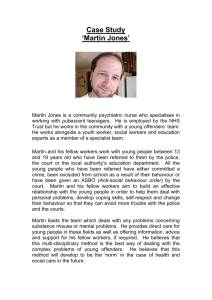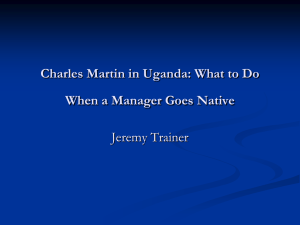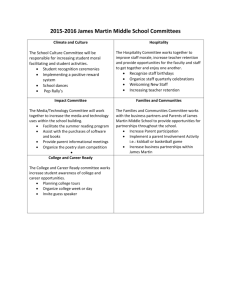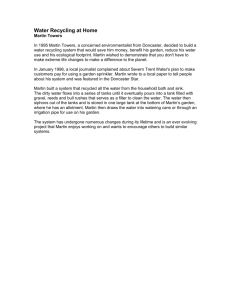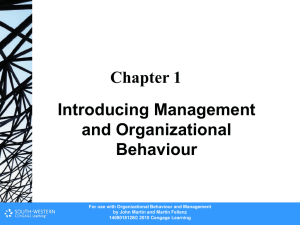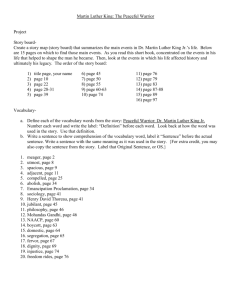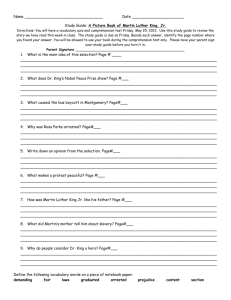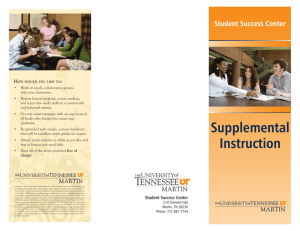Chapter 8
advertisement
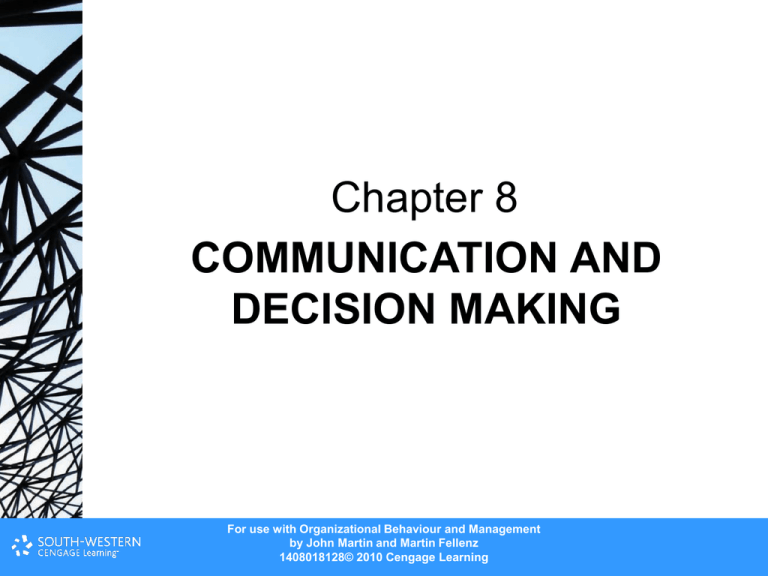
Chapter 8 COMMUNICATION AND DECISION MAKING For use with Organizational Behaviour and Management by John Martin and Martin Fellenz 1408018128© 2010 Cengage Learning Definitions • Communication - the process by which people convey and receive information to and from each other • Decision making - a process of selecting a particular course of action from among the options available • Problem solving - the activity of generating a solution to a recognized problem For use with Organizational Behaviour and Management by John Martin and Martin Fellenz 1408018128© 2010 Cengage Learning A model of communication • Figure 8.1 For use with Organizational Behaviour and Management by John Martin and Martin Fellenz 1408018128© 2010 Cengage Learning Human communication Figure 8.2 For use with Organizational Behaviour and Management by John Martin and Martin Fellenz 1408018128© 2010 Cengage Learning Human communication within organizations Figure 8.3 For use with Organizational Behaviour and Management by John Martin and Martin Fellenz 1408018128© 2010 Cengage Learning The two dimensions of communications • Figure 8.4 For use with Organizational Behaviour and Management by John Martin and Martin Fellenz 1408018128© 2010 Cengage Learning Increasing number and complexity of communication linkages For use with Organizational Behaviour and Management by John Martin and Martin Fellenz 1408018128© 2010 Cengage Learning Communications within organizations Communications in large organizations needs to be managed carefully: • Limitation • Procedure • Teamwork • Automation • Separation •Jargon For use with Organizational Behaviour and Management by John Martin and Martin Fellenz 1408018128© 2010 Cengage Learning Communications processes Communication - four general functions: • Information processing • Co-ordination • Visioning • Personal expression Methods of communication: • Written • Oral • Non-verbal • Electronic For use with Organizational Behaviour and Management by John Martin and Martin Fellenz 1408018128© 2010 Cengage Learning The manager’s communication network • Figure 8.6 For use with Organizational Behaviour and Management by John Martin and Martin Fellenz 1408018128© 2010 Cengage Learning Seating arrangements for effect • Figure 8.7 For use with Organizational Behaviour and Management by John Martin and Martin Fellenz 1408018128© 2010 Cengage Learning Non-verbal communications •Table 8.2 For use with Organizational Behaviour and Management by John Martin and Martin Fellenz 1408018128© 2010 Cengage Learning Listening Skill Sets • Table 8.3 For use with Organizational Behaviour and Management by John Martin and Martin Fellenz 1408018128© 2010 Cengage Learning Guidelines for providing effective interpersonal feedback •Table 8.4 For use with Organizational Behaviour and Management by John Martin and Martin Fellenz 1408018128© 2010 Cengage Learning Guidelines for receiving interpersonal feedback •Table 8.5 For use with Organizational Behaviour and Management by John Martin and Martin Fellenz 1408018128© 2010 Cengage Learning The Johari Window and the processes for increasing awareness (1) •Figure 8.8a For use with Organizational Behaviour and Management by John Martin and Martin Fellenz 1408018128© 2010 Cengage Learning The Johari Window and the processes for increasing awareness (2) Figure 8.8b For use with Organizational Behaviour and Management by John Martin and Martin Fellenz 1408018128© 2010 Cengage Learning Factors influencing decision processes and outcomes •Figure 8.9 For use with Organizational Behaviour and Management by John Martin and Martin Fellenz 1408018128© 2010 Cengage Learning Decision making models • Programmed and non-programmed decision making • Rational model • Bounded rationality model For use with Organizational Behaviour and Management by John Martin and Martin Fellenz 1408018128© 2010 Cengage Learning Heuristics Heuristics refer to mental shortcuts or cognitive ‘rules of thumb’ Judgemental heuristics, biases and errors: •availability heuristic •representativeness heuristic •prospect theory •endowment effect •anchoring and adjustment effects •illusion of control •hindsight bias •implicit favourite bias •nonrational escalation of commitment For use with Organizational Behaviour and Management by John Martin and Martin Fellenz 1408018128© 2010 Cengage Learning Group-level decision making • Concordet Jury Theorem • Concordet’s Paradox • Group polarization (risky shift phenomenon) • Groupthink For use with Organizational Behaviour and Management by John Martin and Martin Fellenz 1408018128© 2010 Cengage Learning Symptoms of Groupthink •Table 8.6 For use with Organizational Behaviour and Management by John Martin and Martin Fellenz 1408018128© 2010 Cengage Learning Preventing groupthink • Figure 8.10 For use with Organizational Behaviour and Management by John Martin and Martin Fellenz 1408018128© 2010 Cengage Learning Improving decision making within groups and teams • Janis (1982, 1989; Janis & Mann, 1977) suggests a decision making approach involving: – Identifying decision objectives and the requirements that make the decision successful – Developing as complete a set of well-defined options – Searching out extensive information regarding the relative merit of different options – Engaging in critical and reflective assessment of the options – Reconsidering and re-examining all the pros and cons of the alternatives – Assessing and if possible improving the costs, benefits, and risks associated with the preferred choice. – Developing implementation plans, monitoring of progress and appropriate action of risk factors interfere with decision implementation For use with Organizational Behaviour and Management by John Martin and Martin Fellenz 1408018128© 2010 Cengage Learning Improving decision making within groups and teams • • • • • • • • Devil’s advocate Dialectical Inquiry Reflexivity Production paradox Brainstorming Nominal Group Technique Delphi Technique Stepladder technique For use with Organizational Behaviour and Management by John Martin and Martin Fellenz 1408018128© 2010 Cengage Learning Models of organizational decision making • Management science model • Carnegie Model • Incremental Decision Making Model (science of muddling through) • Garbage Can Model For use with Organizational Behaviour and Management by John Martin and Martin Fellenz 1408018128© 2010 Cengage Learning Daft’s Contingency Framework for Using Decision Models • Figure 8.11 For use with Organizational Behaviour and Management by John Martin and Martin Fellenz 1408018128© 2010 Cengage Learning Conditions regarding technical knowledge and goal consensus • Figure 8.12 For use with Organizational Behaviour and Management by John Martin and Martin Fellenz 1408018128© 2010 Cengage Learning
